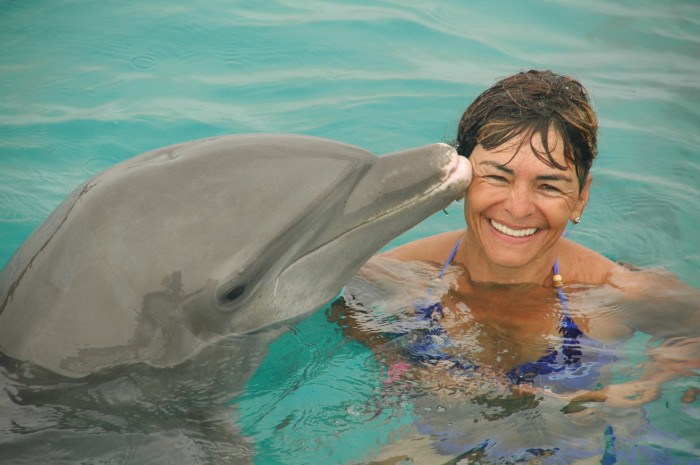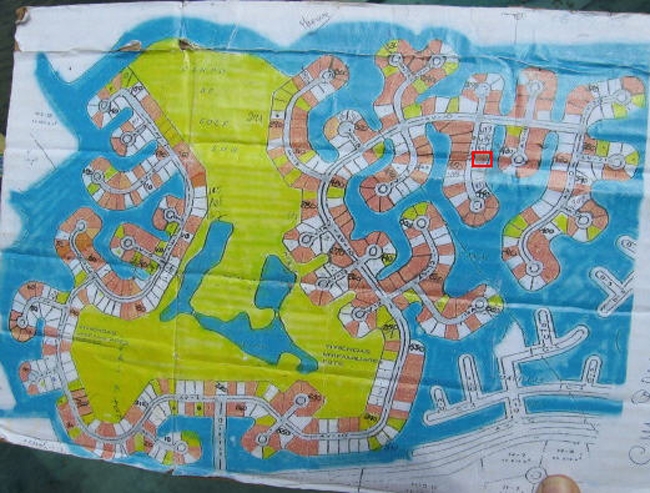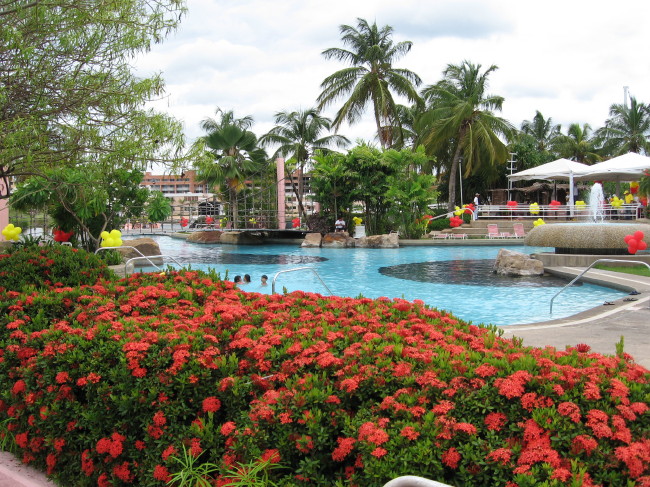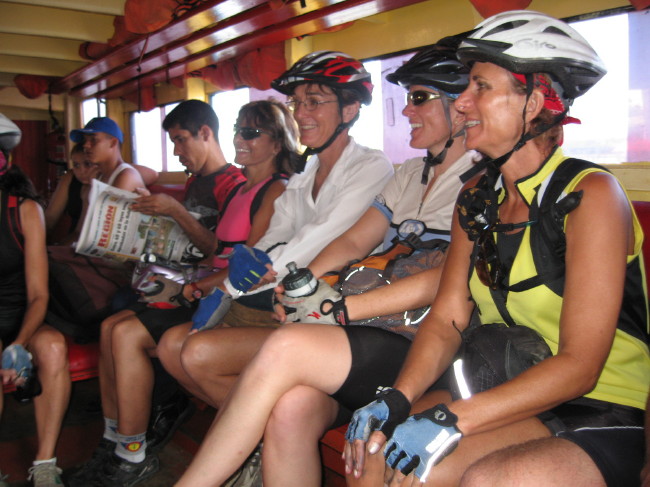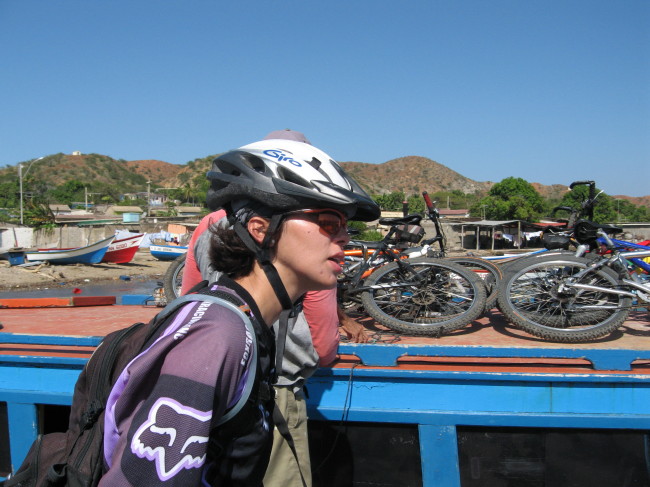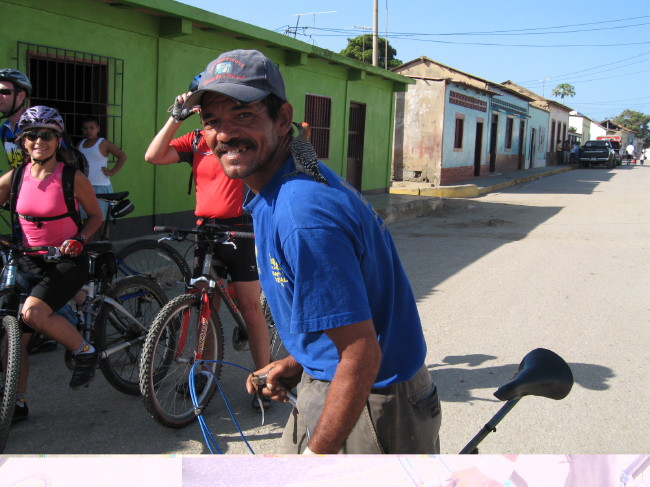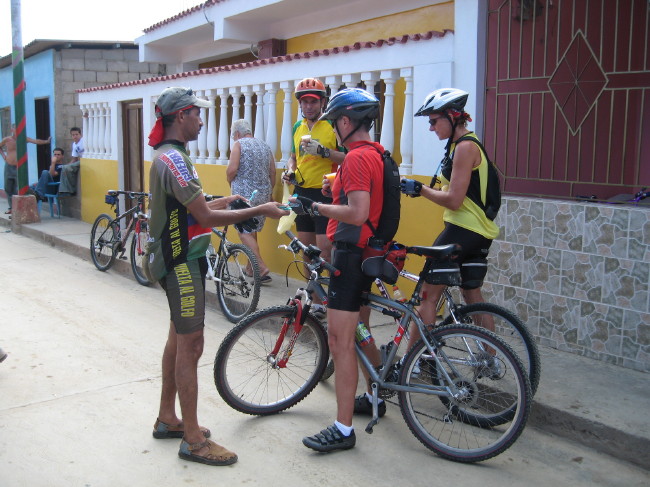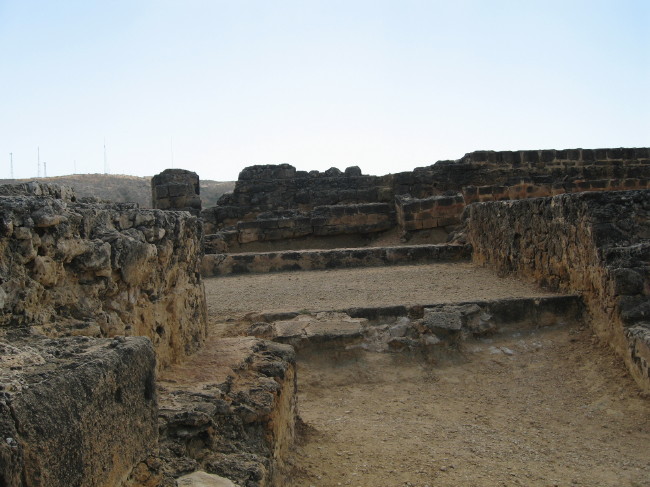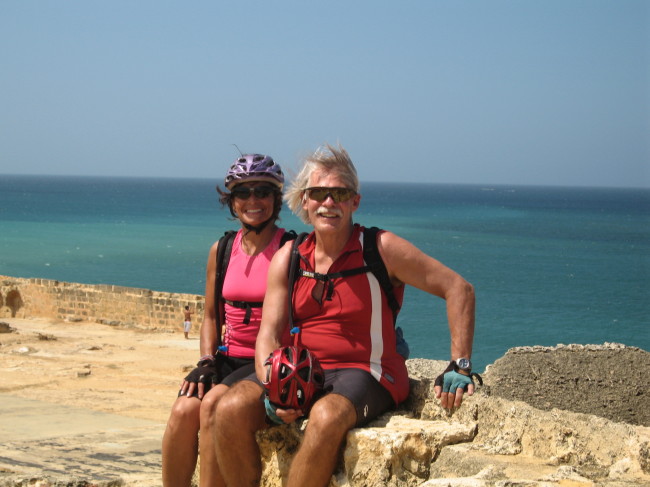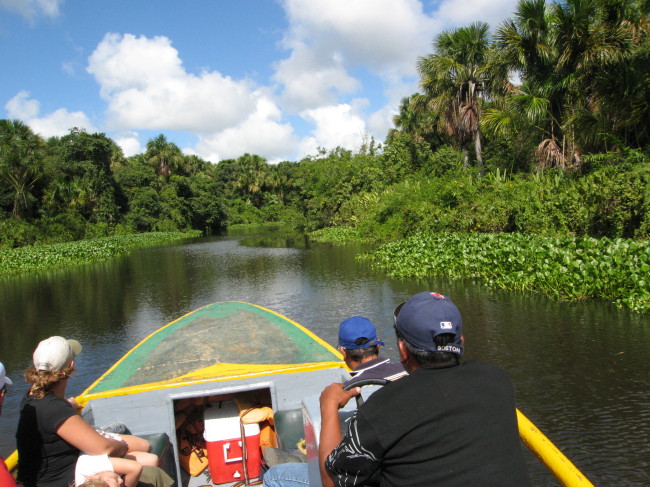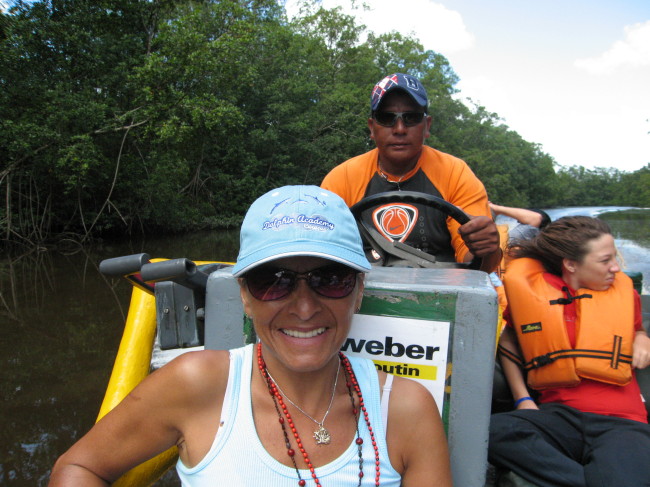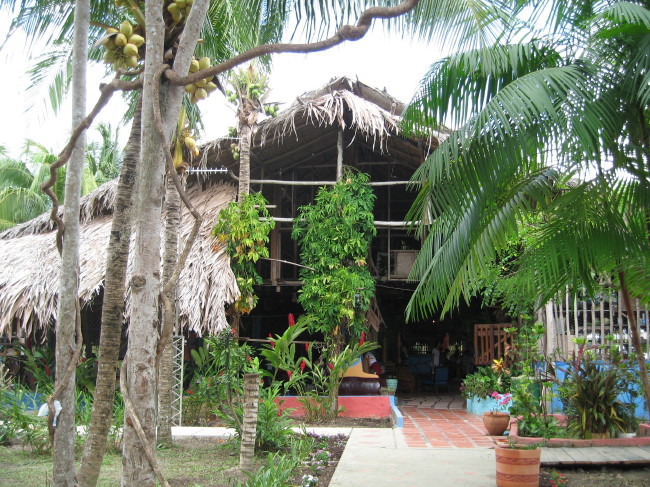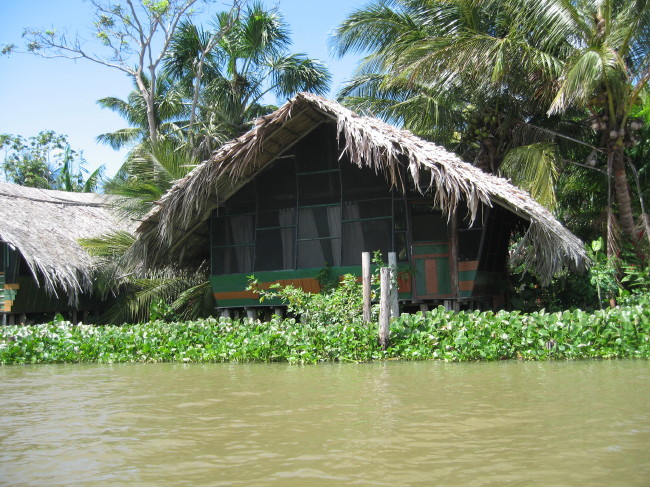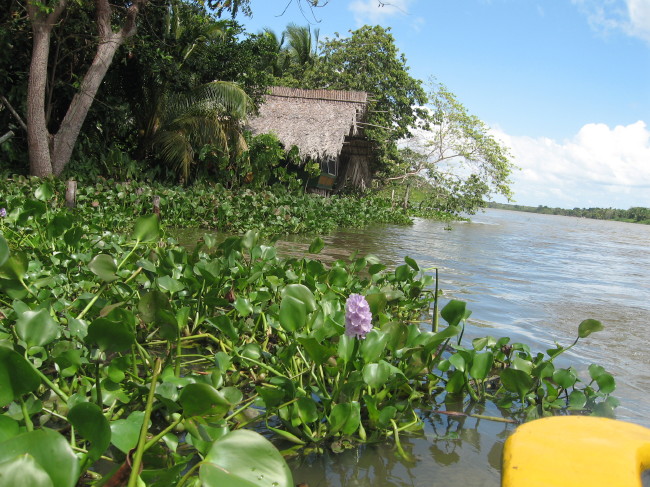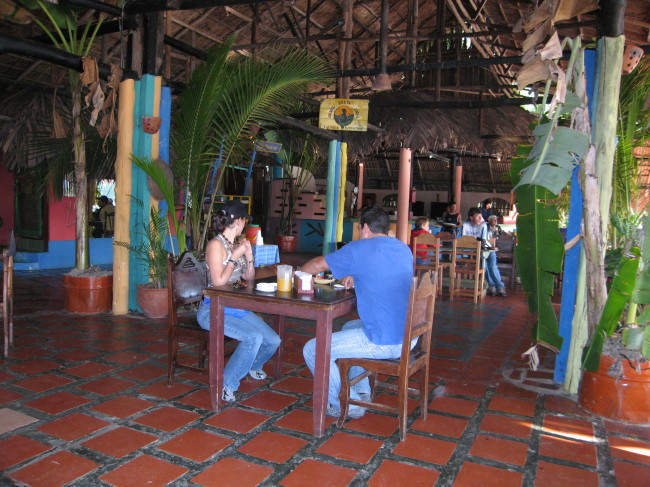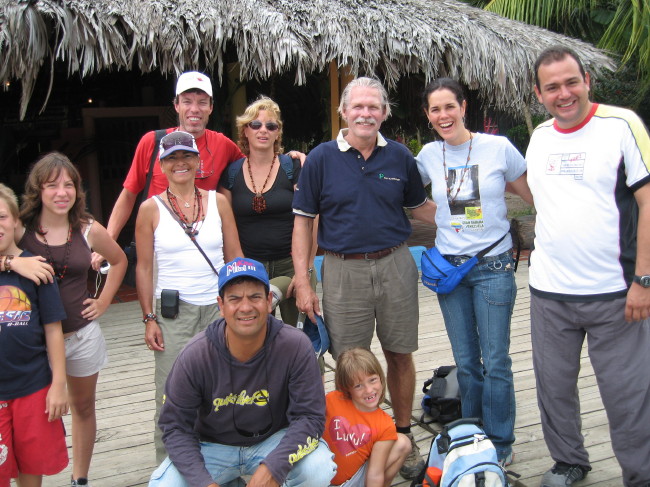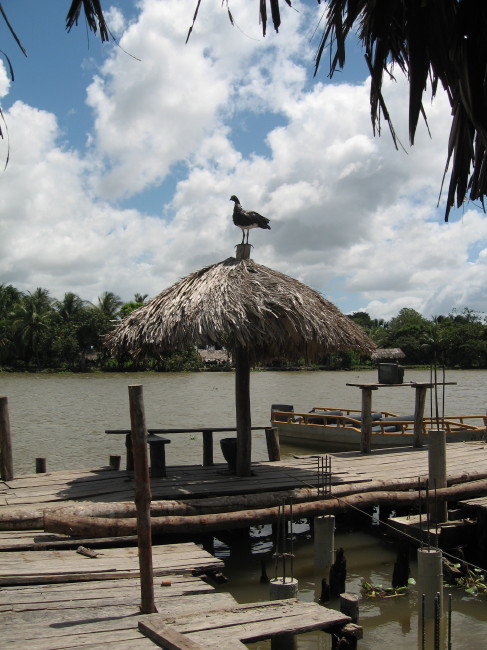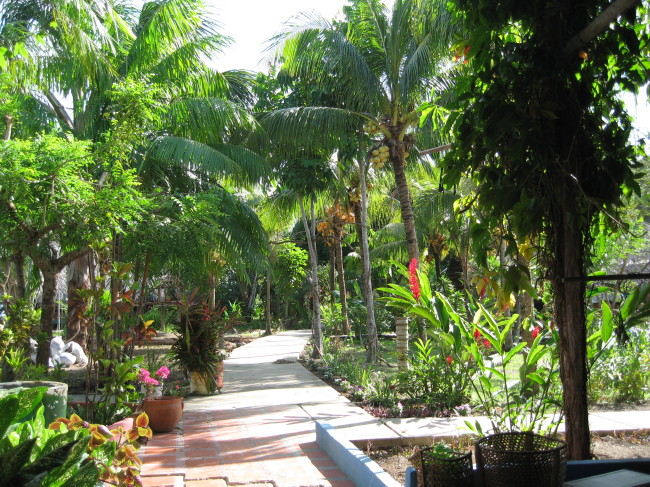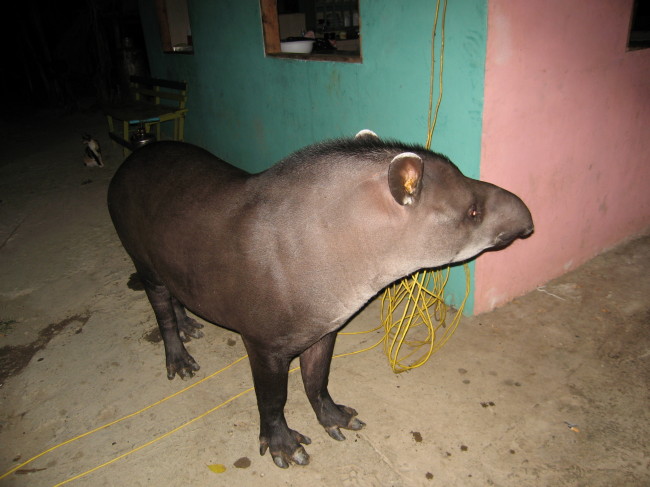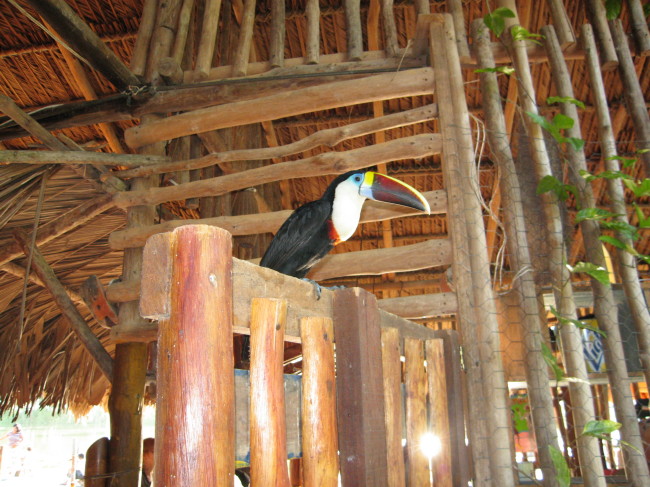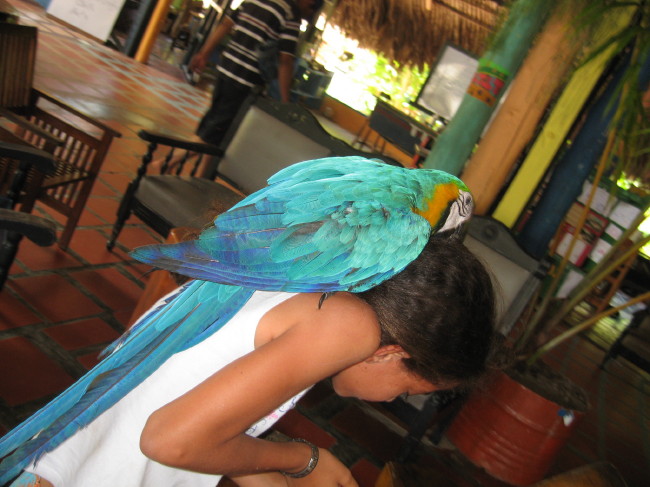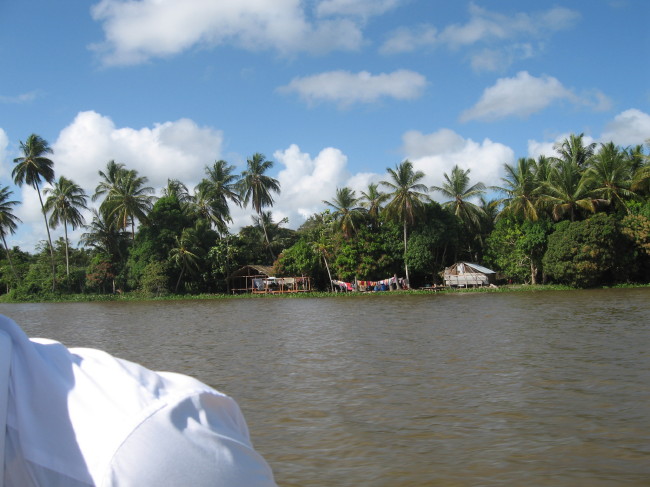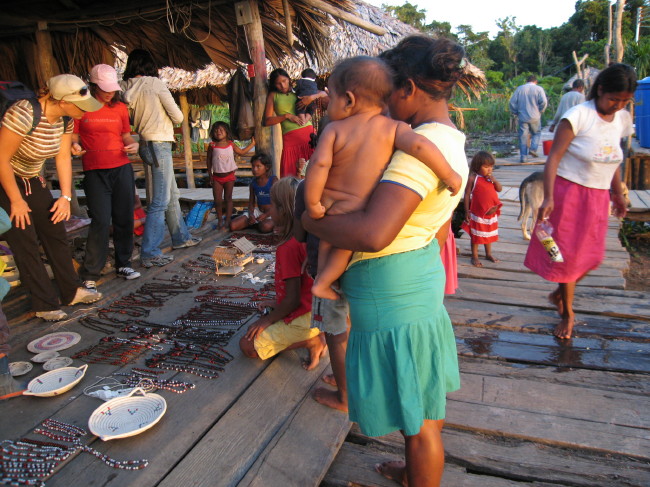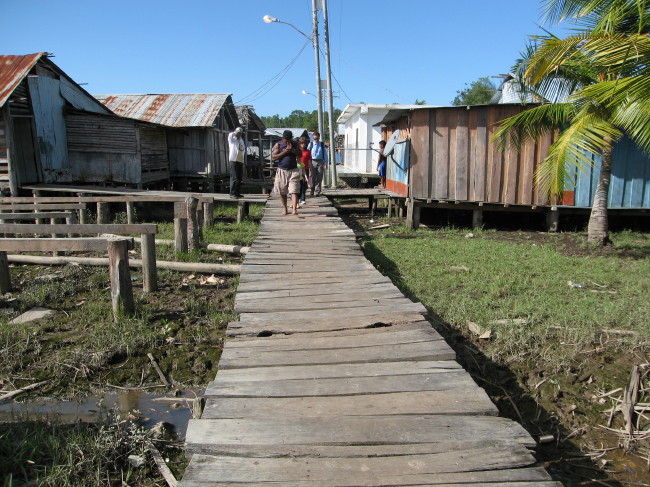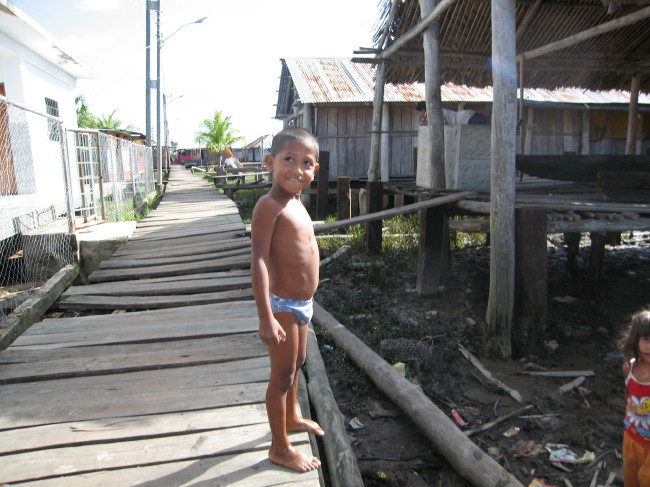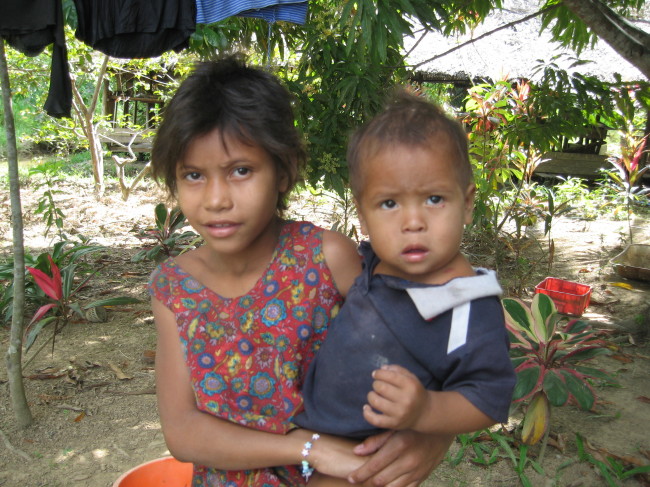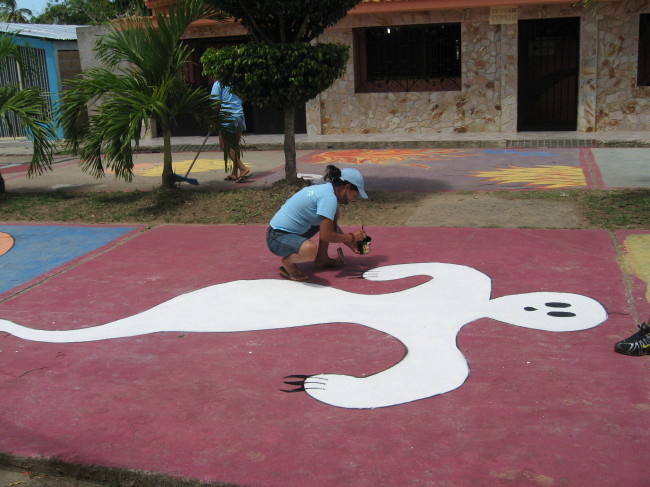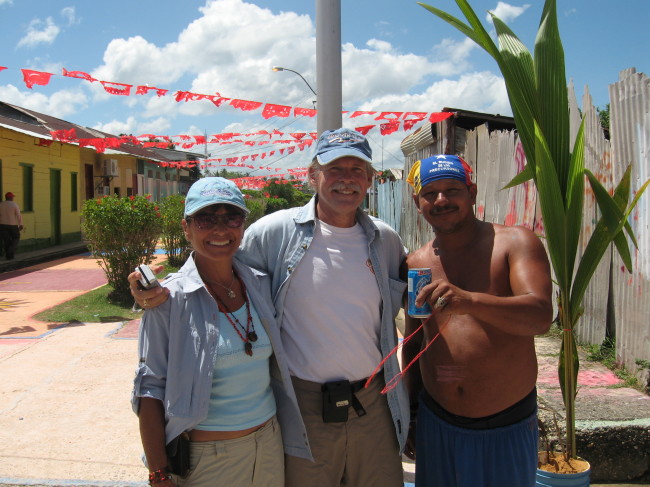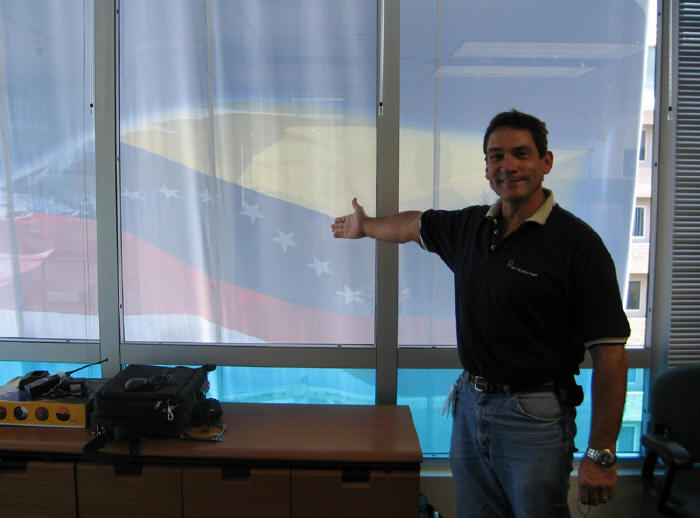|
Bernadine and I flew to Puerto La Cruz via Caracas on August 20, 2006, for a one-week house-hunting trip. We stayed at the Maremares resort on the coast and each day was taken around by a local real estate agent searching for a house for what we expected to be a two year stay. PLC is located at 9-degrees north latitude in eastern Venezuela along the southern Caribbean where the climate is tropical with temperatures generally in the 90's. The coastline is lushly vegetated with tropical plants, occasional coral reefs, abundant dolphin, fish of all kinds, and spectacular beaches. The people are of all ethnicities and the government gave up trying to classify them since there has been so much inter-breeding. Now more than 50% of the people are classified simply as “mixed”. They tend to be attractive people (especially the females) and are humble, pleasant, and hospitable.
Bernadine Connelly eating red snapper on island near La Piscina.
We found a nice house in the Las Villas canal complex, which was to be vacated by a British National in two months (436 Avenida 18, Las Villas, Lecheria). The house was about 4000 square feet with four bedrooms, three bathrooms, three noisy air conditioners, and fully furnished. It was constructed of stone and concrete with lovely tropical landscaping and a large swimming pool and cabana next to a large stone boat dock. Obviously it was far more house than Bernie and I needed, but it was only going to cost us $1500/month and ConocoPhillips would pay the rest as part of my expat package. What's more, CoP would do all of the lease paper work and all we had to do was move in. Due to adverse political and living conditions in Venezuela, CoP paid me a 30% premium on my pay as additional compensation.
Our house at Las Villas.
We flew back to Farmington, then immediately had to fly to Houston to go to ConocoPhillips' corporate office where we had an EAP interview and a medical examination with a company doctor. The EAP interview is the psychological profiling CoP required to insure employees were stable enough for expat assignments in foreign countries, and to our surprise, we passed. We returned to Farmington and began making arrangements to leave the States for an extended stay abroad. We gave our cat (Lion) to Bernie's folks, but decided to bring our dogs (Willy and Sienna), and our cat (Chaco) with us. At the last minute, we bought a house in Golden with the money from our Farmington house, which we sold to the relocation company. This way we felt we were grounded in Golden and would have a place to come back to when we left Venezuela. Celeste and Alex moved into the Golden house on Foothill Road while we were gone, then we moved into it upon our return from Venezuela in 2007. When the moving van came to our Farmington house at 5720 Jackrabbit Junction on September 15, 2006, we split our goods into four piles: 1) those going into long-term storage, 2) those being shipped to PLC by boat, 3) those being shipped to PLC by air, and 4) those being trucked to our new house in Golden. It got confusing and we lost track of where we sent some things. Three days later, the goods arrived in Golden and I helped unpack, and then headed to PLC to start my new job at Petrozuata. Bernie remained in Golden for six weeks until our house a Las Villas was available and our goods on the slow-boat arrived in PLC. My room at Maremares Resort was on the 2nd floor and overlooked the yacht harbor and the Principle Canal. Outside my window was a cluster of date palms where a three-foot green iguana lived right at window level. It was a comfortable and quite room and my six-week stay was enjoyable. WiFi Internet was available in the main lobby, which was a pleasant five-minute walk through the lovely groomed tropical grounds. A small coffee shop was located in the lobby area and I quickly learned to say “café marron” for my 'brown coffee', also known as 'coffee with milk' (not to be confused with “café con leche” which is about half coffee and half milk). I soon became a regular at the shop and they coached me with my Spanish, so soon it was 'café marron para llevar', and I could count the change. The “para aqui o para llevar” was simply 'for here’ or ‘to go'.
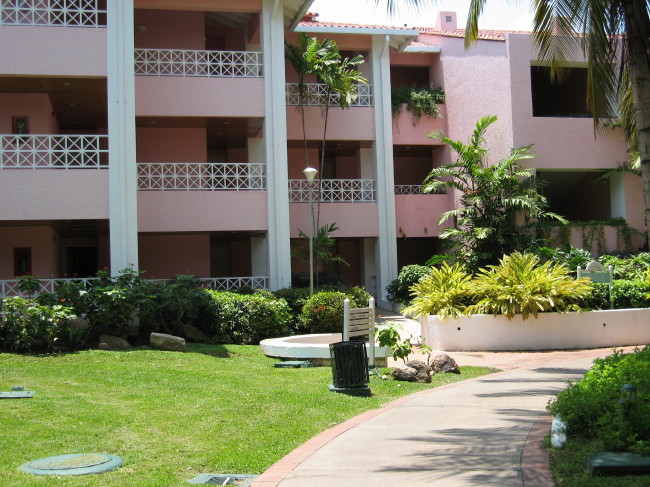
Maremares resort in Puerto La Cruz.
The chime of my computer starting in the morning become a welcome sound and was my link to family and friends back in the States. There were other expats staying at Maremares and slowly we began to recognize each other; none however were Americans. Ironically, two Iranian petroleum engineers became my closest contacts and we made distasteful jokes about how poorly our countries were getting along. A Petrozuata driver would pick me up at 7:30 in the morning and drive me across town to the Petrozuata Building, then drive me back to Maremares in the evening. The drive generally took at least 30 minutes and was miserable due to heavy traffic, poorly maintained roads, and absolutely no adherence to traffic laws. On these roads, 'might made right', and the old taxis were the Kings of the Road. They were 1970's vintage American cars with plenty of dents and scratches and driven by seasoned and aggressive cabbies. These drivers had nerves of steel and wouldn't mind driving a short distance on a sidewalk to get an edge on another driver. Manhole covers commonly were gone, so it was important to remember where the holes were, less you get a flat and bend an axle. Ingress lanes for housing developments and businesses were always used as right-hand passing lanes. After a while, I realized it was best not to watch, especially when the driver told me, “mucha cola hoy” (a lot of traffic now). The drivers spoke not a word of English, so the pressure was always on to learn more Spanish. 'Left', 'right', 'straight', times of the day, and distances were critical. Often I would have to call the office or a friend and have them translate to the driver via cell phone. Bob Kopper was the Chief Geologist at Petrozuata and my new Boss. He welcomed me to the group and took me to my new office, which looked like it perhaps once was the janitor's quarters. It was out of the mainstream though and had a window, which I soon learned was a coveted status symbol. Most geologists and engineers on the 17th floor had inside offices or cubicles, so this windowed office, as odd as it was, was to be treasured. It took some cleaning since my predecessor, and the predecessor before him, had left behind numerous unwanted boxes of stuff and piles of papers. But after a week, I had it looking as though I'd been there months. Immediately I needed to learn more Spanish, so I started Spanish lessons my third week and had three lessons weekly in my office with a personal tutor.
Marieta, our Spanish tutor and friend. Petrozuata was aggressively drilling multi-lateral wells in the prolific Orinoco Belt and had three rigs drilling when I arrived. Pilot wells were drilled to about 2500 feet, then three or four 3200-foot horizontal laterals were drilled from each pilot well. The Officina Formation was Miocene in age and included 27 stratigraphic units; 23 of them were oil productive. The formation was deposited as a deltaic complex and individual sands were channelized and discontinuous, and difficult to map. Maps had been constructed on all 27 horizons and oil reserves had been estimated for ConocoPhillips and PDVSA (Petróleos de Venezuela S.A.). This was an ongoing job however since every new well caused the maps to change; this is where I fit in. As new wells were drilled and logged, I would pick the new tops and bases of the various sands and add them into the OpenWorks database using SeisWorks, StratWorks, Petrosys, and Excel. I can't begin to explain the complexity of this task since the wells were subhorizontal and would porpoise through the discontinuous sand sequences. I was the keeper of the 'Gold Tops' and no one could add or change tops in the database but me. As the wells were drilled and tops modified, I had to manually change the isopach maps of the various sands in Petrosys. However, the data was coming at me like a fire hydrant and maps continually needed updating. Simultaneously, new wells needed to be designed based on our learning from prior wells. We needed to be sure no oil was unnecessarily left behind in this maze of deltaic channels; and we needed to be sure not to collide with the myriad of existing wellbores.
As we drilled lateral wells, penetration rates sometimes approached 1000 feet per hour. We always intended to stay in a particular sand horizon, but too often the sand would pinch-out unexpectedly. Since we used 'measure while drilling' technology, we could see well logs from the formation almost as soon as they were penetrated. This allowed us to re-design the laterals 'on the fly'. When we lost our sand, sometimes we would drill an 'up bone' followed by a 'down bone': we would drill an abrupt upward inclined hole, pull back into the horizontal lateral, then drill an abrupt downward inclined hole. I would take the logs from the up-bone and the down-bone and create a simulated verticalized exploration log and correlate it to other exploration logs in the area to determine where we were stratigraphically. Then I'd remap the sands and pick a new target. The engineer would re-design the well path; the driller would back off into the horizontal lateral, build a new trajectory, and drill toward my new target. All this would happen in a matter of hours and was almost like navigating and piloting a submarine.
At year-end, the reserves needed to be updated based on the last year's drilling. This was a daunting task. Danny took the lead on this and had been doing the task since the beginning of Petrozuata in 1996. Danny was a very bright Venezuelano and I gained much respect for him during this process. All of the net sand isopach maps were created by manual contouring in Petrosys. However they were to be gridded in Z-Map, a Landmark product which is old and difficult to use. I was a seasoned Z-Map user, I thought. We imported the Petrosys contour files into Z-Map and gridded them, but in the course of the year's updates of the maps, some of the sands now contained too much oil due to overly optimistic isopach mapping. So they needed to be edited in Z-Map. Manually editing contours in Z-Map is brain damaging. Danny was good at it, but I struggled. I argued that the entire contouring and gridding process could be done in Petrosys much more easily, but Danny resisted because Petrosys created gridding anomalies near zero contours. I reminded him that Z-Map creates similar anomalies near zero contours and required inserting pseudo contours near the zero contours to prevent the anomalous features, but Danny was steadfast. I took it upon myself to create a test area to do a 'grid off' between Petrosys and Z-Map, which ended up with virtually identical results with the two workflows. If Venezuela hadn't Nationalized us, I believe we would have done a Petrosys-only workflow the next year and done away with Z-map all together. Our house at Las Villas became available October 25, 2006, and I was excited finally to receive las llavas. Our goods arrived from the States soon thereafter, followed by Bernadine, Willy, Sienna, and Chaco. We located a housekeeper and gardener, and soon felt as though PLC had been our home for many months. We rode our mountain bikes regularly up El Morro mountain (along with many locals) early in the morning before the heat of the day. We got to know some Venezuelano riders who invited us on several excursions to remote single-tracks we would never have found on our own and would never have attempted without local Venezuelanos shepherding us. We developed some close friendships during these adventures.
Bottom of El Morro mountain bike ride.
A curious side story occurred early one Sunday morning driving east along the windy coastal road near Marina Passeo Colon on our way to a ride bikes at Araya Peninsula. The military set up a checkpoint and the two cars in the group ahead of us (with Venezuelanos) were waved through, but they stopped Bernie and me. I was driving our 4Runner and, being a blue-eyed Caucasian, I stood out like a sore thumb. A stern soldier walked up to my window and demanded (in Spanish) to see my documents, which I provided. Then he said with a disgusted tone, “Norteamericano”, to which I gleefully responded, “se, yo soy Norteamericano, y me esposa es Norteamericana tambien”. Then he said with a sour face and an even more disgusted tone, “Gringo”. Then I really put on my happy face and bubbled back, “se, Gringo”. At this point, he couldn't hold his stern composure any longer and cracked a big smile. His cover was blown and he gave back my documents and sent us on our way.
El Zamuro bike ride.
We arrived at the Araya Ferry Landing at 8AM and loaded our mountain bikes on top of the tiny wooden ferry, along with boxes of groceries, fruit, lumber, and other goods being transported that morning across the channel. The ferry held about 30 passengers and we sat on wooden benches just above water level in a cabin with many windows. As we sat there with the locals, we looked out of place in our spandex shorts, jerseys, and cycling helmets. The three gringos in the group really stood out. During the ride, a young Venezuelano boy got sea sick and vomited all over himself and his mother and they were struggling to clean up the mess. I gave them a roll of TP from my pack and made a good impression for us gringos and got many smiles. The voyage across the inlet was rough and water splashed over the top of the ferry, and our expensive bikes were soaked in salt water. When we off-loaded them on the Peninsula, we hosed them off with fresh water as best we could, then proceeded with our ride. We rode through a tiny but colorful village, then out into the countryside and along a coastal trail. We ended up at an old Spanish fort that dated back two centuries and was constructed to protect a nearby salt mine. Eventually the mine flooded with water so the Spanish left, but now the Venezuelans mine the salt for themselves. The company used to be called “Salaraya”, a cleaver pun, but was nationalized post-Chavez to “Ensal”. On our return ride, I located some blueschist metamorphic rocks, which evidenced the peninsula accreted to the mainland along an ancient subduction zone. At this point, we were a short ferry ride back to our cars and a two-hour drive back to PLC.
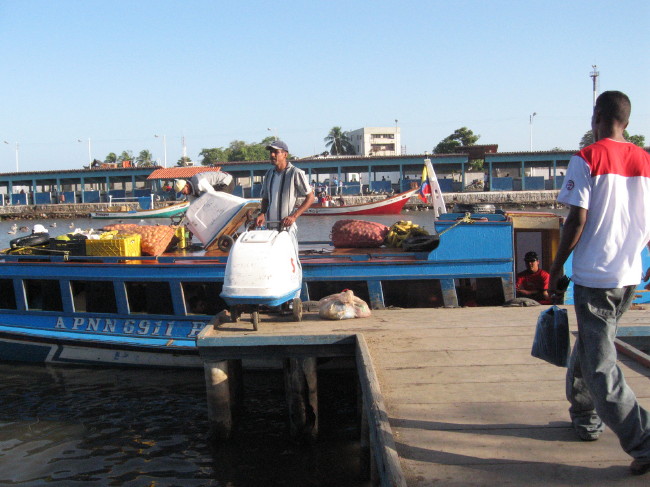
Araya Peninsula ferry and bike ride.
Celeste, Alex, Serene, and Mike came to visit us in PLC for Christmas and we had a grand time showing them the country. Mike brought me two new rims for my bike since I bent mine coming down El Morro; and Alex brought us some outdoor speakers and installed them at our house before leaving. We chartered a boat and went diving at La Piscina where we enjoyed the colorful fish and coral, plus we saw lots of dolphin along the way. We ate at our favorite little restaurant on a nearby island and everyone ordered red snapper and watched the green iguanas snack on the leftover food the chef put out for them. A lady selling local pearls stopped by our table and the gals all bought jewelry. It was such a pleasure to have the kids visit and the house felt empty when they headed back to the States.
Alex and Celeste Cardoso, Mike and Serene Wardinsky at Las Villas house at Christmas.
We never knew how long we were going to remain in Venezuela since Hugo Chavez and his band of socialist Chavistas kept threatening to nationalize Western companies. So we made a point of seeing all we could at every opportunity. I bought a used 2003 Toyota 4Runner I found on the website elcarro.com and got a Venezuelan driver's license, and we were mobile. Some expats were intimidated by the lawlessness of the roads and either didn't drive, or only drove locally, using company drives whenever possible. This was especially true for the wives. But this was not a bit true for Bernie and me. Bernie became a good driver and navigator, and she and her friends ventured off where ever they pleased, 'red zone' or not. We drove west to Caracas, east to the Orinoco Delta, and south to the Gran Sabana and Brazil. I found myself becoming as reckless and lawless as the Venezuelanos when I got behind the wheel. As a teenager, I sold newspapers at the Santa Anita Race Track and learned to drive in an old '49 Plymouth in the crowded 40-acre parking lot after the races. I could get out of that parking lot faster than anyone due to my steady nerves and lack of any sense of decency. Move over Venezuelanos, this isn't my first rodeo. I recall racing someone during a trip north from Cuidad Ordez toward PLC, sometimes over 100mph. Bernie was sleeping. I recall being passed on a tight inside turn on a small coastal road, only to have someone else pass the passer, all completely blind. When it was all said and done, I was the first one out of the turn. I learned never to stop at stop-lights unless there was a car coming on the cross street, less I get rear-ended by someone tailgating me and not expecting me to stop. Yes, I was an indoctrinated Venezuelano driver. This all came very natural for me and was something of a sport. I memorized the locations of the coverless manholes, the ingress right-hand passing lanes, and anticipated all the cabbie maneuvers before they attempted them. When I returned to the States, I had a long detox transition period during which people were reluctant to ride with me. Stop signs were the hardest for me, and continue to be a problem. Bob Kopper always requested that expats who worked for him to let him know where we were going on the weekends in case there were an unexpected evacuation due to the political instability. One Thursday afternoon, I told Bob I was going to drive to the Gran Sabana and continue south to the border of Brazil, but I'd be back to work Monday. Bob just sat in his office chair and looked at me with a blank face, wondering if I was serious. When I unfolded my road map and showed him my route, he realized I had every intention of making the drive. He asked who was going with me, and I said I was going solo since Bernie was in the States. He assured me it couldn't be driven in three days since he'd driven it before with his family. I left at 4AM Friday and reached the Brazil border before stopping that night. Then I turned around and drove a short distance back before finding a humble room in a tiny village in the mountains where I slept for three hours. Before sunrise, I was back on the road and enjoyed a colorful sunrise over the Gran Sabana. I was fortunate enough to see a small aardvark crossing the road early that morning. The sun hadn't risen Sunday morning when I arrived back in PLC and promptly sent Bob an email: “I made the round trip in 42 hours”.

Aardvark crossing road in Gran Sabana early in the morning. Our favorite trip in Venezuela was to the Orinoco Delta in the far eastern side of the country. It took six hours to drive to the end of the roads on the delta where we parked the car and were picked up by a small motor boat. The boat took us on an hour ride through a series of deltaic channels to the remote Orinoco Lodge. This was a lovely rustic facility where a handful of guests had screened huts on stilts on the delta. The quarters were nice and clean, and let us experience living in this special place. Tropical birds and creatures of all kinds abounded and sounds of the jungle mesmerized us. Water-lily pads drifted about with the tides, and occasional fresh water dolphin would leap from the water. We had no concept such a place existed. The eating and social area was open-sided with a magnificent thatch roof. A wild Toucan and an Amazon parrot flew into this area to greet the guests and beg for food. A large tapir strolled in from the jungle like he owned the place and walked among the tables. We later learned the owners rescued him as a baby and now he returns to the lodge from time to time and we were lucky enough to be there for one of his visits. Tapirs are pachyderms and are related to elephants.
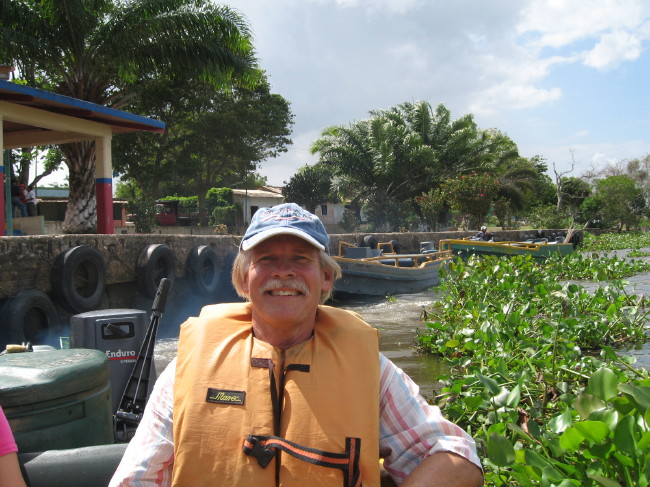
Bill Connelly on boat ride from car to Orinoco Lodge.
We stayed at the Orinoco Lodge for three nights and each day the small boats would take us on another excursion out on the delta. We visited a primitive native village where the Warao lived in open sided huts and the children were nude. We swam with piranha and saw rare blue fresh-water dolphin. The birds deserve a chapter of their own since there seemed to be no end to the variety of species. My favorites were the bird-of-paradise and the scarlet ibis.
A lot of the draw for me to go to PLC was its coastal setting and I bought a 12-foot Achilles inflatable boat before leaving the States. I was so anxious to be back to the ocean so I could enjoy water sports such as boating, diving, swimming, and fishing, after living so long in the Rockies. I bought a small outboard in PLC and drove my small launcha around the bay where we went to restaurants and shopped at the mercado to buy groceries. But the 12-foot inflatable was too small to take out in the open ocean where we could dive in the coral reefs, so we bummed rides with friends and chartered boats from time to time while I looked for a proper ocean going craft of our own.
Before the election of December 3, 2006, everyone was reluctant to buy boats or cars since we were concerned about civil unrest if Chavez lost; Chavez wouldn't relinquish power readily. Now that Chavez was re-elected, the search for a boat intensified. After much searching on tulancha.com, I found a suitable 33-foot outboard located on Margarita Island. On January 14th, Bernie and I flew to Margarita Island to inspect and drive the boat and fell in love with its slick lines, mini cab, twin 250hp outboard motors, electric anchor, single-sideband radio, and cool paint job. This was a proper seagoing boat and could cruise at 50mph in the open ocean. A week later, $40,000 was wired to my Venezuela bank account and converted to Bolivar. We completed all of the legal title work with the local government office and were ready to fly back to Margarita to consummate the deal. I stopped by Kopper's office and told him I would be on Margarita for the weekend and would be driving my new boat back across the channel, but would be at work on time Monday. Again, he sat there in his office chair with a blank look on his face, staring into my eyes to see if I was serious. When I showed him my pile of legal documents and Bolivar, he just shook his head and said, “Bill, haven't you been paying attention?” Well, he had my attention, but I wasn't entirely clear what he meant; though figured it had to do with Chavez. He pulled his door closed and said, “I think we're going to be nationalized soon and the last thing you need now is a 33-foot boat. Expats are going to be giving them away in a couple weeks.” This was sound advice and I didn't buy the boat, and we got nationalized shortly thereafter. I tempted myself to buy it anyway and drive it back along the islands, but that would have been just plain dumb. As Kopper predicted, by early February, expats were selling their boats at 'fire sale' prices.
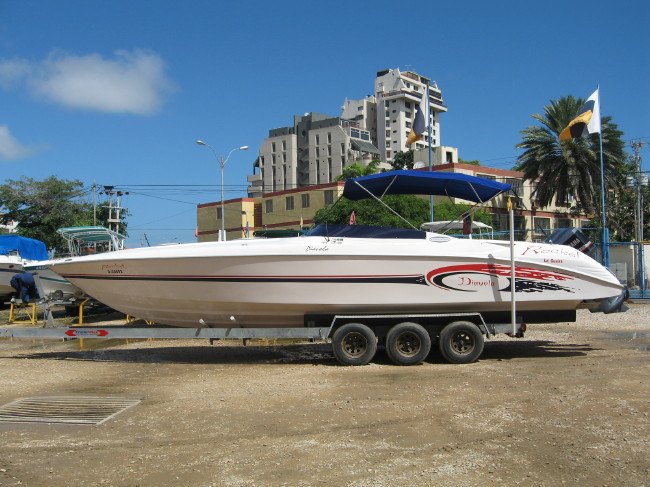
I nearly bought this 33' boat named "Rocket" out on Margarita Island. It was a fine sea worthy craft with two 250hp outboards and could cruise at 50mph in the open ocean.
Our last three months in Venezuela could be characterized as “a tense time in paradise”, as we waited for final word ConocoPhillips would be nationalized and we would be reassigned to unknown locations. Bernie and I went for a glorious week of R&R in early March to the Galapagos Islands before ConocoPhillips’ R&R program was discontinued. Upon return, it was announced ConocoPhillips and Exxon were to be nationalized May 1st. We diligently watched for available expat or domestic openings with ConocoPhillips, but the pickings were slim. In the end, I was transferred to Midland, Texas (along with Bob Kopper), and was to report to work on June 4th. I drove Bernie and the pets to Caracas and they departed for Denver April 9th. Bernie was anxious to leave Venezuela and all the confusion and uncertainty of nationalization, but she wished the best to her good Venezuelano friends we were leaving behind to deal with Chavez. I left Venezuela on May 8th

This was my going away poem to Bob Kopper which I wrote on the inside cover of the Venezuela picture book the Team gave him on our last day in the Petrozuata office. It’s a song to be played to a Reggaeton tune with a driving Latin beat. Se llama Senor Roberto Go to Chapter A
|

